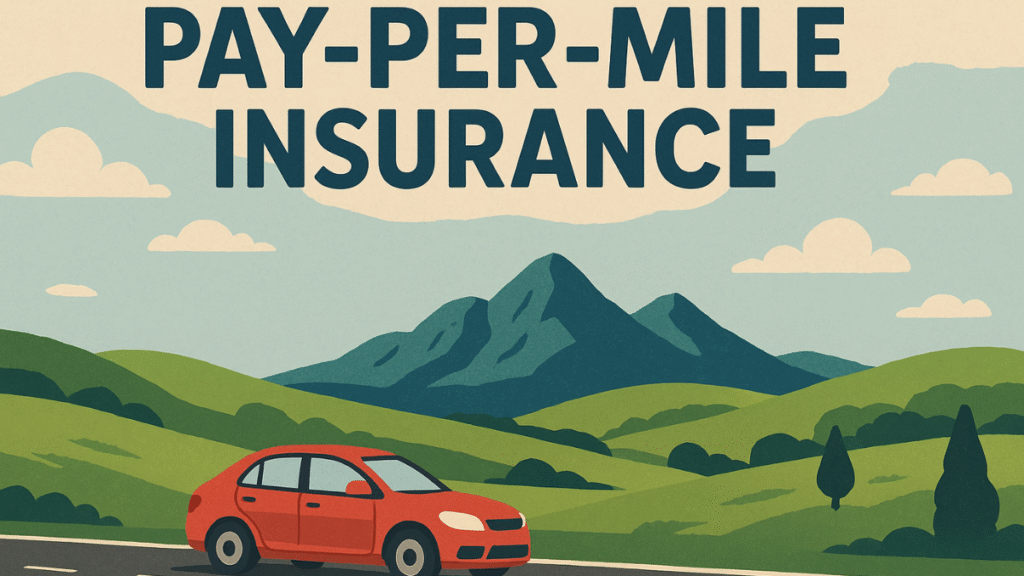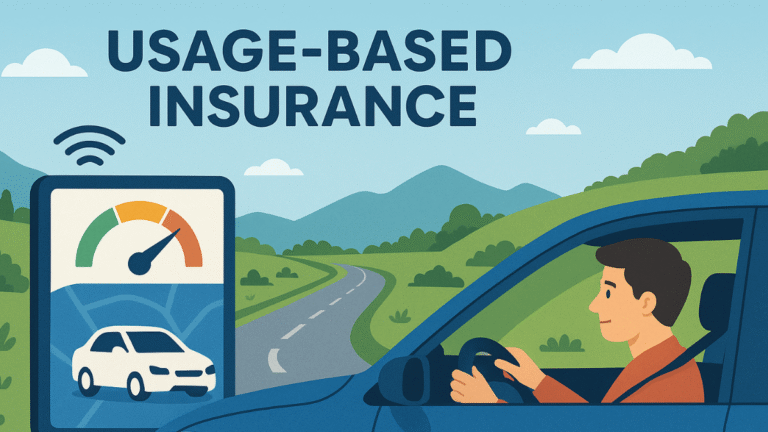In an age of smart technology and personalized services, Usage-Based Insurance (UBI) is transforming the way auto insurance works. Instead of paying a fixed premium regardless of how much or how safely you drive, UBI allows policyholders to pay insurance based on their actual driving behavior. This data-driven approach not only promotes safer driving habits but can also lead to significant cost savings for careful drivers.
Understanding Usage-Based Insurance (UBI)
Definition of Usage-Based Insurance
Usage-Based Insurance is a type of auto insurance where the premium is determined by the driver’s usage patterns and behavior. This model uses telematics technology—devices or mobile apps that collect real-time data such as speed, mileage, braking habits, and time of day the vehicle is driven.
Unlike traditional insurance that relies heavily on historical data and demographic factors (like age or location), UBI evaluates how a person actually drives.
How UBI Works
UBI programs typically work in three ways:
- Pay-As-You-Drive (PAYD) – Charges are based on how many miles you drive.
- Pay-How-You-Drive (PHYD) – Charges are based on driving behavior such as acceleration, braking, and speed.
- Manage-How-You-Drive (MHYD) – Offers real-time feedback and driving tips for safer behavior.
Data is gathered through a telematics device plugged into the vehicle or through a mobile app. Insurers analyze the data to determine risk levels and adjust premiums accordingly.
Types of Usage-Based Insurance Programs
1. Pay-As-You-Drive (PAYD)
This model primarily tracks the number of miles driven. People who drive less are considered lower risk and may benefit from reduced premiums.
2. Pay-How-You-Drive (PHYD)
PHYD goes a step further and considers how you drive. It tracks:
- Speeding
- Harsh braking
- Sharp cornering
- Acceleration habits
These metrics help insurers reward safer drivers with discounts.
3. Pay-Per-Mile Insurance

Similar to PAYD, this program charges a base rate plus a per-mile fee. It’s especially useful for people who work from home or use public transport regularly.
4. Behavior-Based Insurance
In this model, your driving style significantly affects your rates. Safe drivers with good habits receive better scores and lower premiums.
Benefits of Usage-Based Insurance
1. Personalized Premiums
UBI offers customized pricing. You pay for how much and how well you drive, not based on generic criteria.
2. Cost Savings
Careful drivers, infrequent drivers, and commuters who drive short distances often enjoy significant discounts.
3. Improved Driving Habits
Since drivers know they’re being monitored, many adopt safer driving practices—leading to fewer accidents and violations.
4. Enhanced Claims Management
Telematics data helps in accident reconstruction, making it easier to process claims and reduce fraud.
5. Environmental Impact
Driving less and driving safely reduces fuel consumption and emissions, supporting eco-friendly habits.
Challenges of Usage-Based Insurance
1. Privacy Concerns
Telematics devices gather extensive data, which raises concerns about data privacy and surveillance.
2. Data Accuracy
External factors such as road conditions or traffic can influence driving behavior but might not be considered in score calculations.
3. Limited Availability
UBI is not available in every region or from all insurers. Access depends on location and carrier.
4. Device Compatibility
Some vehicles may not support telematics devices, and mobile apps may drain phone batteries or require constant connectivity.
Who Should Consider UBI?
UBI is ideal for:
- Low-mileage drivers
- Remote workers
- Students or retirees
- Safe and defensive drivers
- Urban dwellers who use public transportation
If you fall into any of these categories, switching to UBI could lead to substantial savings.
How to Enroll in a UBI Program
Step 1: Check Availability
Verify if your insurance provider offers UBI programs in your state or region.
Step 2: Choose a Plan
Pick between PAYD, PHYD, or other models based on your driving habits and needs.
Step 3: Install Telematics
Install a telematics device in your car or download the insurer’s mobile app. Ensure it is compatible and properly configured.
Step 4: Drive and Get Evaluated

Drive normally, but safely. Your behavior and mileage will be recorded over a specific evaluation period (often 30 to 90 days).
Step 5: Receive Adjusted Premium
At the end of the evaluation, you’ll receive feedback and possibly a discount based on your driving score.
What Data Is Collected?
UBI programs typically collect the following:
- Distance driven
- Time of day (e.g., night driving may be riskier)
- Driving speed
- Braking intensity
- Cornering patterns
- Phone usage while driving
- Location and GPS tracking
This information helps insurers build a profile and assess risk more accurately.
Telematics: The Technology Behind UBI
Telematics is the backbone of UBI. It combines GPS, sensors, and onboard diagnostics (OBD-II) to collect and transmit driving data. There are three main types of telematics systems:
- Plug-in devices (OBD-II)
- Mobile phone apps
- Built-in vehicle systems (smart car tech)
Insurers use this data to calculate premiums, detect accidents, and even dispatch roadside assistance if needed.
UBI vs. Traditional Auto Insurance
| Feature | Usage-Based Insurance | Traditional Auto Insurance |
|---|---|---|
| Premiums | Based on actual usage | Based on age, gender, location |
| Data Use | Real-time driving behavior | Historical data and risk models |
| Flexibility | High – changes with driving | Low – static unless manually updated |
| Rewards | Safe driving discounts | Often limited to loyalty or bundling |
UBI provides a fairer pricing model, especially for safe and low-mileage drivers.
Myths About Usage-Based Insurance
Myth 1: It Invades Your Privacy
Reality: Most UBI programs are transparent about what data is collected, and users must give consent.
Myth 2: It’s Only for Young Drivers
Reality: UBI can benefit drivers of all ages, especially those with good driving habits.
Myth 3: It Tracks You All the Time
Reality: Data is typically only collected while you’re driving, and not during personal downtime.
Myth 4: It’s Hard to Set Up
Reality: Most systems are plug-and-play or simple app downloads, requiring little technical knowledge.
The Future of Usage-Based Insurance
With the rise of AI, IoT, and connected vehicles, UBI is expected to grow rapidly. Insurers are exploring advanced analytics to offer:
- Real-time policy adjustments
- Customized safety tips
- Integration with smart city traffic systems
- Loyalty rewards for consistent safe behavior
As technology advances, UBI may become the industry standard, replacing flat-rate premiums entirely.
Also Read: Effective Strategies For Insurance Lead Generation
Conclusion
Usage-Based Insurance (UBI) represents a modern shift in auto insurance, offering personalized premiums based on actual driving behavior rather than outdated risk models. It’s not only cost-effective but also promotes road safety, eco-friendliness, and data-driven decision-making.
For those who drive safely or don’t drive much at all, UBI could be the key to unlocking lower insurance costs and greater peace of mind. As insurers continue to embrace technology, UBI is poised to become the future of car insurance.
FAQs
1. Is Usage-Based Insurance legal in all states?
Not all UBI programs are available in every state. Some states have restrictions on telematics or data usage, so availability varies by region and insurer.
2. Can UBI increase my premium?
Yes, some insurers may raise premiums for high-risk driving behavior detected during the monitoring period, but many programs only offer discounts, not penalties.
3. Will my driving data be shared with third parties?
Reputable insurers typically do not share personal data with third parties without consent. Always review the privacy policy before enrolling.
4. Can I opt out of a UBI program after joining?
Most programs allow you to opt out, though you may lose associated discounts. Check the terms and conditions of your specific policy.
5. Does UBI affect my credit score?
No, UBI programs do not impact your credit score. They assess your driving behavior, not financial history.

